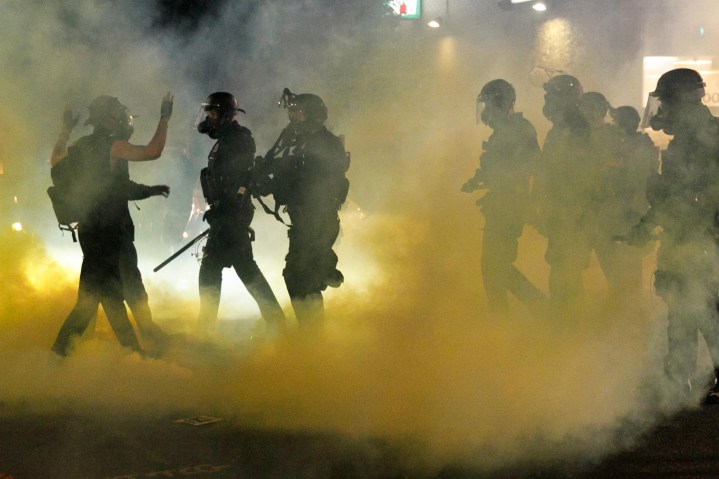
When the uprisings following George Floyd’s death began to spring up around the nation, Caroline Bailey found that following along with the protests on social media came with an added dimension of confusion.
The fragmented, rapidly unspooling documentation of popular rage was chaotic enough. But Bailey, who’s been deaf since birth, also found that most videos lacked captions or transcriptions – something that she needed in order to be able to understand what was going on in her country.
Over the past month and a half, protests have waxed and waned, but the uprisings are ongoing. In Portland, Oregon, crowds are being clubbed and teargassed by a volatile mix of local police and federal agents. In New York, crowds still surge, on bikes and on foot, along the avenues, demanding more radical changes to policing than those offered by a recalcitrant city council. And in the St. Louis suburb of Florissant, Missouri, police recently set up a “designated protest area,” arrayed themselves in a fearsome, bristling riot line, then shot nonlethal rounds and gas into the crowd.
In rural towns, from Ohio to Virginia to Idaho, small protests have been met with white-power vigilante violence of astonishing ferocity. By mid-July, though, the uprisings – though they have not abated – have trickled out of headlines in national media. But on social media, the images continue to flow unchecked. Minute-by-minute content from the streets pours across the screen in a flurry of teargas, sweat, munitions, and imprecations for justice.
Those who seek information, resources, and knowledge about what’s happening across the country – or in their town – turn to tweets, Facebook livestreams, and Instagram posts and Stories. Even for people without a disability, keeping track of ongoing uprisings in countless cities can be daunting. For Deaf, Hard of Hearing and Blind social media users, the inherent inaccessibility of videos on Twitter and elsewhere makes the task nearly impossible.

“I’ve always just kind of scrolled past videos, believing they probably wouldn’t have captions or weren’t that important for me to watch,” Bailey told me. “I think with the George Floyd protests, his murder, Black Lives Matter specifically, it seemed like there were way, way more videos than normal. And they were all talking about things that were incredibly important. It felt like this massive movement, and I didn’t want to be left out of it. I wanted to know what was going on in cities across the country.”
Enter ProtestAccess – an organization of volunteers across the country and world that work tirelessly each day to make Black Lives Matter-related content accessible to the Deaf, Hard of Hearing, and visually impaired communities.
Transcriptions for those who need it most
Recently, a video of protesters challenging a press conference by the mayor of Louisville, Kentucky, went viral, and Bailey found herself looking at yet another protest video with no captions or transcription. This time, though, she had somewhere to turn.
Bailey follows a lot of Deaf activists and those with disabilities, and she had seen ProtestAccess swim across her timeline over the past month. In response to anyone tweeting at or tagging their Twitter handle with the hashtag #ProtestAccessRequest, ProtestAccess drops in to offer transcriptions, captions, and accessible explanations to those who need it most. Over the past weeks, it has captioned dozens of videos, from city council commentary to street action, police brutality to poetry.
Within a day or two, ProtestAccess provided Bailey with a captioned video, which it posted to Twitter, and a full transcript, provided via a link to Pastebin. The transcript, designed for visually impaired people, lays out each frame of the video in minute detail:
[People start walking out behind the mayor, holding a large white banner]
But not to celebrate our successes and celebrate our people would also be an injustice as well.
[Two people, one wearing a Black Lives Matter T-shirt, unfurl the large white banner. It has an image of a fire on it and reads: “[cut off] re! Fire! [cut off] ntrifier”.
Another person comes behind the mayor, waving a Black Lives Matter flag.]
So when you think about what we’re trying to do here in the city and what we’re trying to do to the country, there’s really no — [Large numbers of protesters gather behind the mayor, carrying signs. The mayor continues without seeing them] nothing more fundamental —
Protester: [chanting] Fire! Fire!
[cowbells clang]
All protesters together: [chanting] Gentrifier!
[Fischer attempts to speak more loudly over protesters, then stops]
How ProtestAccess works
Here to provide captions and transcripts for social justice content—we are currently focused on the #BlackLivesMatter movement & protests. Please tag us in a video if you would like it captioned or transcribed and we will do our best to make it accessible to you.
— ProtestAccess (@ProtestAccess) June 1, 2020
“The group of folks who had tagged themselves as available to volunteer to do this work began organizing through Twitter messages,” she told Digital Trends.
When that proved disorganized and overwhelming, the group moved toward the sophisticated, multiplatform method of organizing that it currently employs – a seamless dance of tech designed to transmit content seamlessly from requester to volunteer and back again.
To become a volunteer with ProtestAccess, you first have to send an email to the group, then fill out an application form listing your abilities, available time, and the roles you’re willing to fill. A small and bustling world then opens up to you: A series of Google Docs laying out standards for transcription, ethics, and community guidelines; a board on project management app Trello, where assignments are posted, claimed, and updated; and a Discord chat where volunteers discuss assignments, crowdsource difficulties with indistinct audio or accents, fine-tune captions, and get to know one another.
The chat is active day and night, with assignments streaming along the Trello board as ProtestAccess volunteers work to fulfill requests from Twitter users who want – desperately – to be part of an ongoing conversation they often cannot hear.
‘We caption without question’
One thing ProtestAccess organizers stressed publicly and privately is that they don’t pick and choose between what content they provide transcripts for. If a video is requested, that request must be honored, regardless of whether it is traumatizing – depicting police brutality or violence – or if it provides information ProtestAccess volunteers think might be inaccurate or slanted. In response to users questioning a video called “How to Ethically Protect Yourself or Someone Else When a Horse Is Being Used As a Weapon,” which was captioned by a volunteer, the ProtestAccess account said as much in no uncertain terms.
One thing ProtestAccess organizers stressed publicly and privately is that they don’t pick and choose between what content they provide transcripts for.
“We respond to requests and we caption without question. The whole point of captioning, transcribing, and creating alt-text for videos and content is to give people with any sort of barrier access to the same content that hearing and sighted people take for granted every day. It would be paternalistic, inappropriate, and, frankly, highly unethical for us to pick and choose what content we believe is ‘good’ enough, or ‘factual’ enough, or ‘appropriate’ enough for us to make accessible,” read a series of Tweets from the @ProtestAccess account in early June. “Picking and choosing the content we make accessible would suggest that we do not think our Deaf, Blind, [hard of hearing], and [English as a Second Language] followers are just as capable and intelligent as hearing, sighted, and fluent English speakers to determine whether or not they agree with or believe in a video or piece of content.”
For volunteers, transcribing and describing traumatic content can take a toll.
“The hardest thing I’ve encountered is the processing of content that’s emotionally and mentally hard to watch,” volunteer Jo Stoeger said. “Access is important, and the trauma that is captured in a video does not exclude it from being worthy of accessibility … .”
“So seeing these videos where people are brutally beaten, racism is denied, white supremacy is touted with a just-the-way-it-is attitude is probably what’s hardest for me,” Stoegler added.
But being part of ProtestAccess, for some organizers, is a way to engage with an unmet need – and make the world of protest a broader, better place.
“Social justice is a conversation that everyone should be a part of, but how can someone be a part of a conversation that isn’t accessible to them? Without accessibility, there is no social justice,” volunteer Micah Fahar said. “This is the biggest civil rights movement to date, and everyone deserves to know what’s going on, and to use that knowledge to decide how to participate. Everyone deserves to know what is happening to the world they live in, and to use that knowledge to decide how to act.”
Editors' Recommendations
- Twitter is testing closed captioning button for videos
- Watch Google’s Wing drones make deliveries to folks in Virginia
- As college resumes, students protest against invasive proctoring apps
- TikTok’s new Stitch feature lets you quote other creators’ videos in your posts
- NASA progressing on next-generation rocket, but will it make 2021 launch?



